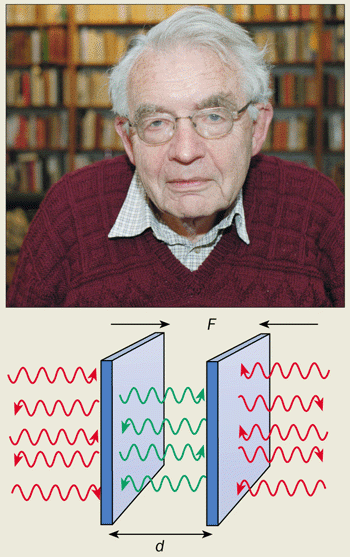-
 Topical antifungal
Topical antifungal
-
 X-43
X-43
-
 Reflection microscope
Reflection microscope
-
 Mica-schist
Mica-schist
-
 Cryosphere
Cryosphere
-
 Lithospheric
Lithospheric
-
 Sundancer
Sundancer
-
 Pothole
Pothole
-
 Carbonatite
Carbonatite
-
 Brine
Brine
-
 Demodulation
Demodulation
-
 Lactic acid
Lactic acid
-
 GEOSS
GEOSS
-
 Acidophile
Acidophile
-
 Chirality
Chirality
-
 Sclerotome
Sclerotome
-
 Mimas
Mimas
-
 Cotyledon
Cotyledon
-
 Zenith distance of a direction
Zenith distance of a direction
-
 S0/T0
S0/T0
-
 A-train
A-train
-
 Ammon's horn
Ammon's horn
-
 Efflorescence
Efflorescence
-
 Cryptochrome
Cryptochrome
-
 Cholinergic
Cholinergic
-
 Phoenicopteriformes
Phoenicopteriformes
-
 Auto-immune diseases
Auto-immune diseases
-
 Gossan
Gossan
-
 Pit
Pit
-
 Blood pressure
Blood pressure
Casimir effect
The Casimir effect, from the name of its discoverer Hendrik Casimir (1909-2000), is a well-known phenomenon from quantum field theory. The Dutch physicist realised that when two mirrors are opposite each other in a vacuum, fluctuations in the vacuum exert a radiation pressure on them.
A vacuum is dominated by quantum fluctuations in the electromagnetic field on an atomic scale, although quantum fluctuations of all the fields of elementary particles must be taken into account to precisely calculate its state, and quantum gravitation has dominant effects on the scale of Planck distances and energies.
The effect of the two plates (see diagram below) is to modify the type of oscillation of the electromagnetic field fluctuations of which the wavelength then changes compared to the exterior of the plates. The final result is that the mean energy between the plates is different from that outside the plates and a force appears tending to bring the two plates together.
On average the external pressure (red arrows) is higher than the internal pressure (green arrows). The two mirrors are therefore mutually attracted to each other by what is called the Casimir force. This is the force F that is proportional to A/d4, where A is the surface area of the mirrors and d the distance between them.
Interest in the Casimir force was reawakened when it was realised that apart from hypothetical effects on quantum gravitation, whether in cosmology or related to black holes or worm holes, it should occur very concretely in the field of nanotechnologies. This is because nanomachine design will have to cater for the appearance of this type of force.
 Credit: Astrid Lambrecht
Credit: Astrid Lambrecht
Latest
Fill out my online form.



